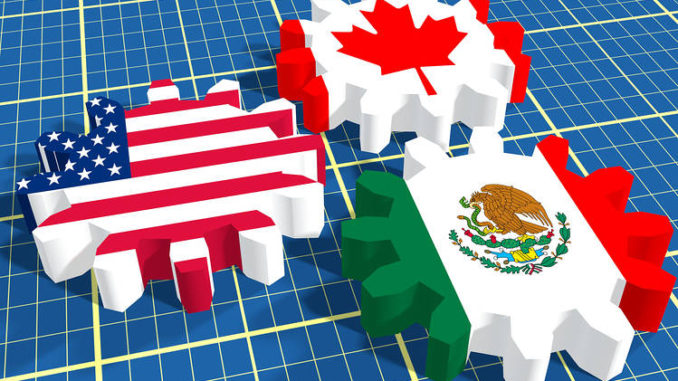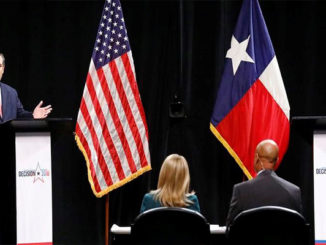
 A commitment to North America will pay dividends not only in terms of economic prosperity for the U.S., but will also have an important impact on national security.
A commitment to North America will pay dividends not only in terms of economic prosperity for the U.S., but will also have an important impact on national security.
Over the past year, the George W. Bush Institute has convened a major effort to analyze the economic relationship that links the U.S. with Canada and Mexico. We did this because we believe that the long-term growth potential of the U.S. economy is fundamentally linked to our ability to innovate and that innovation is driven by global markets. Moreover, we have focused on North America because we believe that it is the cornerstone of a national security strategy for the 21st century.
We started by asking ourselves the question: how competitive are the United States and our North American neighbors?
In Depth
The Bush Institute North American Competitiveness Scorecard is an index that looks at factors that affect economic conditions in countries and trade blocs. As countries compete with each other to attract investment, innovation, and jobs, the Scorecard aims to help us understand where we can improve policy to stimulate growth. Explore the Scorecard
To answer, we assembled a database of measures of competitiveness, openness and freedom assembled by others, including the World Economic Forum, the World Bank, the Fraser Institute and the Heritage Foundation. The result contains a number of surprises, particularly for those who believe that the United States is being left behind in global competition.
North America: Sinking or Swimming Together
The first surprise is that, on our own, the United States out-competes over 91 percent of the 101 countries measured. Our economy’s ability to mobilize investment to support job creation and innovation surpasses that of all but a handful of countries.
Looking at North America compared to other large trading groups, we still out-compete 75 percent of the countries measured. What’s more, we beat the European Union, which comes in at 65 percent.
It is true that the North America score is less than the U.S. score alone, largely because of Mexico’s struggles with the rule of law. In effect, each of the three nations brings strengths and weaknesses to the North American equation, underscoring that we sink or swim together. Above all it is important to keep in mind that part of the U.S. high score is the result of our close trade and investment relationships with Canada and Mexico. Those relationships enable our auto, technology, and aerospace industries to compete.
In effect, each of the three nations brings strengths and weaknesses to the North American equation, underscoring that we sink or swim together.
Room for Improvement
The second is perhaps less surprising: the trend for the U.S. and for North America as a group is down. The U.S. score has declined from 98 percent in 2007 – Singapore territory – to 91 percent in 2015, mostly due to sustained deficit spending and accumulating public debt, and partly due to an increase in business regulation.
We see the result in declining rates of new business formation and the frustratingly slow pace of productivity increases in recent years.
North America as a group has also lost ground, falling from 80% to 75% for the same reasons. And it has slipped in spite of Mexico’s successful macroeconomic policies during this period, which stabilized the nation’s budget and debt and partly counterbalanced the U.S. failure to do likewise.
Next Step For North America

With these observations as a baseline, we then asked ourselves, what would it take to improve the ability of the United States to compete globally?
The scorecard offers an initial approach to this question. As noted, the macro environment has declined in all three countries, most markedly the United States. We all need to get our fiscal houses in order and reverse the relative growth of our public debt. Mexico and Canada have shown the way in this respect over the past several years, although the new Canadian Prime Minister’s proposals for renewed deficits, while potentially triggering needed investment in infrastructure, could undermine this effort.
By the same token, the business and trade environments of all three countries have declined, particularly in the United States. We all need to ensure that our regulations are smart and cost-effective, an effort we can best undertake in coordination at the North American level, and generally get government out of the way of entrepreneurship.
We all need to ensure that our regulations are smart and cost-effective, an effort we can best undertake in coordination at the North American level, and generally get government out of the way of entrepreneurship.
On trade, we are being left behind as other countries and regions open their markets, and seek to compete with us on the global marketplace. Prompt action on the Trans-Pacific Partnership trade deal is imperative, and the U.S. should bring Canada and Mexico into the Trans-Atlantic Trade and Investment Partnership to put ourselves back at the center of world trade where we belong.
The Bush Institute Working Group
Building on this baseline, we wanted to go further. Beginning in September 2015, we brought together a group of experts from policy, business, and academia from all three countries to explore issues that our scorecard doesn’t address.
It happens that these are also issues that lie outside the scope of the North American Free Trade Agreement (NAFTA), which set the parameters for today’s North American market. Energy, often referred to as NAFTA’s “missing chapter,” quickly emerged as a focus.
Rapid technological changes in energy extraction, production and distribution have combined with a remarkable policy opening in Mexico to produce extraordinary opportunity for the North American partners to secure a competitive advantage in industrial production and emerge as global energy leaders across the board – despite oil price fluctuations.
Over the course of our three sessions, the group also noted the slow-motion crisis in border infrastructure taking place in North America. Delays at our land borders are undermining security and adding billions to the cost of production, reducing our ability to compete on world markets.
Finally, we discussed the challenges of human capital development as all three North American partners face the need to ensure that our young people have the skills and knowledge they need to succeed in the 21st century. For all of our efforts to reform, attainment rates are too low, the skills gap continues to grow, and collaboration between business and education remains insufficient.
Securing Our Perimeter by Moving Our Border
That represents a daunting economic agenda. One might wonder if it is worth the effort. Perhaps it would produce additional economic growth and job creation, but would it have greater impact than efforts we might undertake solely within the United States? Why bother to work with Canada and Mexico?
The answer is our national security. And not just in the sense that a thriving economy is the cornerstone of national security. Put simply, for all of its challenges, North America is a pretty good neighborhood. Who among our allies would not rather have Mexico and Canada as neighbors than China, North Korea, Russia, Syria, or Libya?
For all of its challenges, North America is a pretty good neighborhood. Who among our allies would not rather have Mexico and Canada as neighbors than China, North Korea, Russia, Syria, or Libya?
Compared to most other industrialized countries, our perimeter is already quite secure. This is certainly true to the north, where NORAD secures the airspace of the United States and Canada. Except on Christmas Eve, when it provides real-time updates on the progress of Santa’s sleigh, most of us don’t pay much attention to the North American Aerospace Defense Command.

The U.S.-Canada joint military operation coordinates patrols over our territory by the U.S. and Canadian air forces and provides early warnings of any incoming air or maritime threats. But NORAD is so deeply rooted in our joint security that most Americans don’t know that it is a fully binational structure where Canadian and American military personnel work together at all levels to conduct aerospace warning and control in the defense of North America.
NORAD’s commander, an American, and his deputy, a Canadian, support both the President of the United States and the Prime Minister of Canada. Think for a moment about how fortunate we are to have a neighbor who helps secure our northern border, moving our defense perimeter almost 3,000 miles away from our actual border.
Think for a moment about how fortunate we are to have a neighbor who helps secure our northern border, moving our defense perimeter almost 3,000 miles away from our actual border.

It is true that the U.S.-Mexico security relationship is not this advanced. Even though the Mexican cartels are a powerful challenge to law and order in that country, and even though they expend enormous effort to penetrate the U.S. border, it would still be a mistake to fall into the current trap of viewing our southern border as a threat to our national security.
For one thing, unlike some of our allies’ neighbors, our southern neighbor is not a heavily armed power with an aggressively growing military and a doctrine of national security that sees us as its principal threat. On the contrary, relations between the U.S. and Mexican militaries are closer than they have been in a century, and the two coordinate closely and successfully on counter-narcotics operations – just ask Chapo.
For the past several years, the Mexican military has maintained liaison officers at NORAD. The immediate cartel threat is real, but a successful policy could ultimately lead to a security relationship with Mexico more like what we have with Canada, moving our southern security perimeter almost 2,000 miles from our actual border.
Successful policy could ultimately lead to a security relationship with Mexico more like what we have with Canada, moving our southern security perimeter almost 2,000 miles from our actual border.
In short, a renewed commitment to North America will pay dividends for a century in terms of prosperity and security for the United States. More effective public-private collaboration on energy, border infrastructure, and education and training will produce more rapid growth and sustained job creation. A patient long game on national security, driven by a holistic vision of North America’s perimeters, will created an extended zone of stability. We’ll be so prosperous and so secure we’ll get bored.




